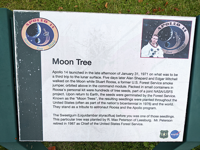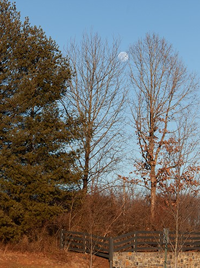For more than 150 years, communities across the country have celebrated Arbor Day to recognize the many ways trees benefit our environment and improve the air we breathe and the water we drink. Before becoming a state, the Nebraska Territory instituted its first Arbor Day on April 10, 1872. Volunteers planted more than a million trees that day, beginning a tradition that would sweep the nation.
Virginia jumped on the bandwagon in 1908. That same year, Virginia E. Randolph, the daughter of formerly enslaved parents and a teacher at a school for African American students in Henrico County, used her own money to purchase 12 plane trees that her students and others planted around the school grounds. The event marked what is believed to be the first Arbor Day celebration at an African American school in the United States.
While Arbor Day is a time to celebrate all trees, one particular tree in Loudoun County has a backstory like no other.
NASA’s 1971 Apollo 14 mission is probably best remembered for when astronaut Alan Shepard hit a golf ball on the lunar surface. But according to NASA, fellow astronaut Stuart Roosa packed hundreds of tree seeds into his personal gear on the same mission.
Roosa was a former US Forest Service “smoke jumper” who fought wildfires in areas virtually inaccessible except by parachute. Ed Cliff, the head of the Forest Service, knew Roosa and asked if he would take some tree seeds into space to see if radiation and zero gravity would affect their viability. (Spoiler alert: They didn’t.) Nearly 500 seeds made the journey, including five tree species: loblolly pine, sycamore, sweetgum, sequoia, and Douglas fir.
NASA history records that Roosa, the command module pilot “Kitty Hawk”, along with his botanical cargo, orbited the moon 34 times while fellow astronauts Shepard and Edgar Mitchell walked the moon. Upon their return to earth, the seeds were distributed to Forest Service offices in California and Mississippi.
Most of the seeds successfully germinated and were passed on to other state forest organizations, schools and universities, many as part of the nation’s bicentennial celebrations in 1976. One was planted on the White House lawn and another was a gift to the Emperor of Japan . Others went to Brazil and Switzerland. Four Moon Trees (as they became known) landed in Virginia, including a sycamore in Hampton, one in Bracey, and another at King’s Dominion Amusement Park in Doswell. The fourth is a sweetgum tree, which is probably closer than most local residents realize.
“Loudoun County is full of hidden gems, and this is just one of them,” said Kraig Troxell, communications manager for Loudoun County Parks, Recreation and Community Services. He admitted that although he has lived and worked in Loudoun for decades, he had never heard of the history of the local moon tree.
According to news reports at the time, the sweetgum tree was struggling to survive and had no home yet. In 1978, the tree was given to then-Deputy Forest Service Superintendent R. Max Peterson of Leesburg to see if he could save it. He nursed it back to health and planted the tree on a friend’s private property east of Hamilton.

The sweetgum tree at the center of this photo orbited the moon 34 times when it was just a seed.
When it came to Virginia Power’s plans for power lines along Rt. 7, Peterson drew their attention and the tree was spared. The land surrounding the tree later became Scott Jenkins Memorial Park, and the tree was preserved for posterity. Today, the Loudoun moon tree is surrounded by a stone wall and surrounded by a wire fence. A sign explains his star power. While it’s not easy to tell the tree from its neighbors, sweetgum can be recognized by its star-shaped leaves and, in the fall, by its round, spiky seed balls.
The park is located at 39464 E Colonial Hwy. east of Hamilton. From the park entrance, keep left and look for the information sign.
Although some of the moon trees have died, more than 50 survive and their locations are documented. NASA’s history of the moon trees, including a list of their locations, is available at: nssdc.gsfc.nasa.gov/planetary/lunar/moon_tree.html
Second Generation Moon Trees can be purchased at americanheritagetrees.org/product/msu-moon-tree/.
[Tim Farmer is a writer, photographer and former newspaper editor, recently retired from the State Arboretum of Virginia who lives near Round Hill. Contact him at tim@timfarmerphoto.com.]
www.loudounnow.com
https://www.loudounnow.com/news/hidden-treasure-loudoun-s-moon-tree/article_0865ea6a-e513-11ed-982e-7b8332f82adc.html














